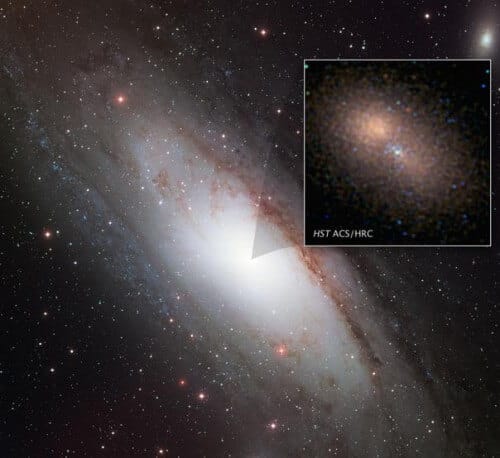This is the sharpest image ever taken of the core of another galaxy

A new photograph by the Hubble Space Telescope reveals the central black hole that has dissolved about 100 million solar masses in the spiral galaxy M31 also known as the Andromeda galaxy. It is the only galaxy apart from the Milky Way that is visible to the naked eye and the second giant in addition to the Milky Way in the local group of galaxies.
This is the sharpest image ever taken of the core of another galaxy.
The event horizon, the near region surrounding the black hole from which light cannot escape, is too small to show, but it is at the center of a compact cluster of blue stars in the center of the image. This compact cluster consists of double stars surrounded by the double shell of M31, discovered by the Hubble Space Telescope in 1992.
The double core is actually an elliptical ring of old red stars surrounding the black hole but at a greater distance than the blue stars. When the stars are at the farthest point of their orbit they move slowly, like cars in a traffic jam. This causes the illusion of a second core.
The blue stars surrounding the black hole are no more than 200 million years old, so they must have formed near the black hole in a burst of star formation. Massive blue stars are short-lived so they do not have enough time to migrate to the black hole region if they were formed elsewhere.
Astronomers are trying to understand how young-looking stars formed so close in the black hole's gravitational field and how they survived in this extreme environment.
The fact that the young stars are so close to the central black hole in our Milky Way also suggests that this may be a common phenomenon in spiral galaxies.
Todd Lauer of the National Optical Observatory in Tucson, Arizona combined the image of the proboscis region using blue and ultraviolet light photographs using the high-resolution channel of Hubble's Advanced Survey Camera. Each time he moved the telescope slightly to change the way the camera samples the area. By combining the images he was able to produce a particularly sharp view of the galaxy's core.
Lower presented his findings at the American Astronomical Society meeting in Austin, Texas.
The large image of Andromeda, to which the new image of the core was attached, is from 2001 and was taken with the 0.9 meter telescope at the University of Alaska in Anchorage.
to the notice of the researchers

7 תגובות
It's not that easy to go through one light second just to leave the earth, it's not easy anymore, you have to invest a lot of resources, time and power just to get to the moon...but you can take resources from other planets and just keep moving forward (hoping you have all the resources)
It is very important to know how many Earth-like planets there are at "correct" distances from their suns. Much more than how many drops of water there are on the moon. If they also manage to discover chlorophyll bands in the spectral analyzes of those planets, the celebration will be perfect. And so was the incentive to develop improved means of propulsion.
Science advances only when each scientist deals with what he understands best, science cannot be directed because then there is a fear of losing ideas that may advance humanity.
OK. Excellent. Very important information. Contributes a lot. Maybe they will start directing resources to the study of the solar system?? We don't even know if there is water in a small and marginal place that is a light second away from us!! I say let's start a resource center and expand the search radius as technology advances!! Think about what we could achieve if all the resources were directed to the moon and Mars... a small example - although statistics of how many stars there are in the universe (when the error range is between 1% and 100,000,000%) are very interesting, but if the minds that worked hard on this exact research were Freeing up to work on something closer and more tangible, they would find things that would speak much more to the decision makers of budget distributions. If you get one drop of water from the moon you will get an unlimited budget to get a drop from Mars as well.
Good Day..
Easy repair:
You wrote: "This is the only galaxy apart from the Milky Way that is visible to the naked eye and the second giant in addition to the Milky Way in the local group of galaxies."
Well, there are other galaxies, in the local group, that can be seen with the naked eye. For example: the galaxies known as the "Magellanic Clouds" (cannot be observed from Israel because they are too southern).
If you had indicated that this is "the only spiral galaxy..." - the sentence would be correct.
The old stars created the young ones just so they wouldn't get bored. They also called this satanic plan a star is born.
What the young people don't understand is that only one survives to the final and all the rest are swallowed up in the black hole before they even had time to grow up.